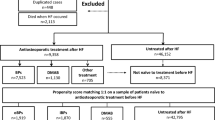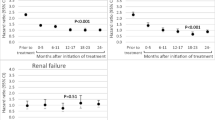Abstract
Summary
We analyzed the association of bisphosphonate therapy with mortality and hip refracture incidence among osteoporosis-related hip fracture patients in Austria. Mortality was lower in primarily female bisphosphonate users, while hip refracture incidence was generally elevated relative to controls, indicating beneficial effects of bisphosphonates other than on bone.
Introduction
The purpose of this study was to analyze mortality and hip refracture risk in osteoporotic hip fracture patients with and without antiosteoporotic medication.
Methods
We retrospectively analyzed data on 31,668 Austrian patients ≥50 years with a hip fracture between July 2008 and December 2010 for antiosteoporotic drug treatment with respect to outcome parameters all-cause mortality, hip refracture incidence, and hip refracture-free days. Outcomes when bisphosphonate (BP) treatment was begun before or after fracture were compared with an age- and sex-matched hip fracture control without antiosteoporotic medication.
Results
27.69 % of patients (33.01 % of women, 13.13 % of men) were prescribed antiosteoporotic medication, primarily BPs. Females having initiated BP treatment before first fracture had lower odds for mortality 1 and 3 year(s) post-fracture, whereas hip refracture incidence under pre-fracture BP initiation was generally higher. Treatment that was started after fracture, however, entailed significantly lower mortality hazards for both genders (HR 0.43, 95 %CI 0.36–0.52, p < 0.0001 after 1 year) but significantly higher hip refracture incidence except for patients aged 50–69 years and more hip refracture free days for females. Hip refractures overall amounted to 29.22/1000 patient years differing significantly between women and men (31.03 vs. 23.89, respectively, p < 0.0001), and longer hip refracture free survival was observed for women than for men (499 vs. 466 median days, respectively, p < 0.0001).
Conclusions
Although BP use is associated with reduced mortality after hip fracture, notably among women, hip refracture incidences are likewise elevated, which is most likely accounted for by a high probability of BP prescription to more comorbid patients suffering from more severe osteoporosis. Concomitantly, through possible effects other than on bone, BPs might be able to curtail mortality. Male hip fracture patients’ low treatment frequency in particular reflects underdiagnosis and undertreatment of osteoporosis in Austria.

Similar content being viewed by others
References
Dhanwal DK, Dennison EM, Harvey NC, Cooper C (2011) Epidemiology of hip fracture: worldwide geographic variation. Indian J Orthop 45:15–22
Haleem S, Lutchman L, Mayahi R, Grice JE, Parker MJ (2008) Mortality following hip fracture: trends and geographical variations over the last 40 years. Injury 39:1157–1163
Armstrong AL, Wallace WA (1994) The epidemiology of hip fractures and methods of prevention. Acta Orthop Belg 60(S1):85–101
McClung MR (2003) Pathogenesis of osteoporotic hip fractures. Clin Cornerstone 5(S2):S22–S29
Bischoff-Ferrari H (2011) The role of falls in fracture prediction. Curr Osteoporos Rep 9:116–121
Boonen S, Lips P, Bouillon R, Bischoff-Ferrari HA, Vanderschueren D, Haentjens P (2007) Need for additional calcium to reduce the risk of hip fracture with vitamin D supplementation: evidence from a comparative metaanalysis of randomized controlled trials. J Clin Endocrinol Metab 92:1415–1423
Abrahamsen B, Masud T, Avenell A, Anderson F, Meyer HE, Cooper C et al (2010) Patient level pooled analysis of 68 500 patients from seven major vitamin D fracture trials in US and Europe. BMJ 340:b5463
Rizzoli R (2011) Bisphosphonates for post-menopausal osteoporosis: are they all the same? QJM 104:281–300
Reginster J-Y (2011) Antifracture efficacy of currently available therapies for postmenopausal osteoporosis. Drugs 71:65–78
Alves SM, Economou T, Oliveira C, Ribeiro AI, Neves N, Goméz-Barrena E et al (2013) Osteoporotic hip fractures: bisphosphonates sales and observed turning point in trend. A population-based retrospective study. Bone 53:430–436
Fisher AA, O’Brien ED, Davis MW (2009) Trends in hip fracture epidemiology in Australia: possible impact of bisphosphonates and hormone replacement therapy. Bone 45:246–253
Brauer C, Coca-Perraillon M, Cutler DM, Rosen AB (2009) Incidence and mortality of hip fractures in the United States. JAMA 302:1573–1579
Dimai HP, Svedbom A, Fahrleitner-Pammer A, Pieber T, Resch H, Zwettler E et al (2011) Epidemiology of hip fractures in Austria: evidence for a change in the secular trend. Osteoporos Int 22:685–692
Cummings SR, San Martin J, McClung MR, Siris ES, Eastell R, Reid IR et al (2009) Denosumab for prevention of fractures in postmenopausal women with osteoporosis. N Engl J Med 361:756–765
Eriksen EF, Keaveny TM, Gallagher ER, Krege JH (2014) Literature review: the effects of teriparatide therapy at the hip in patients with osteoporosis. Bone 67:246–256
Center JR, Bliuc D, Nguyen ND, Nguyen TV, Eisman JA (2014) Osteoporosis medication and reduced mortality risk in elderly women and men. J Clin Endocrinol Metab 96:1006–1014
Sambrook PN, Cameron ID, Chen JS, March LM, Simpson JM, Cumming RG et al (2011) Oral bisphosphonates are associated with reduced mortality in frail older people: a prospective five-year study. Osteoporos Int 22:2551–2556
Lyles KW, Colón-Emeric CS, Magaziner JS, Adachi JD, Pieper CF, Mautalen C et al (2007) Zoledronic acid and clinical fractures and mortality after hip fracture. N Engl J Med 357:1799–1809
Cameron ID, Chen JS, March LM, Simpson JM, Cumming RG, Seibel MJ et al (2010) Hip fracture causes excess mortality owing to cardiovascular and infectious disease in institutionalized older people: a prospective 5-year study. J Bone Miner Res 25:866–872
Beaupre LA, Morrish DW, Hanley DA, Maksymowych WP, Bell NR, Juby AG et al (2011) Oral bisphosphonates are associated with reduced mortality after hip fracture. Osteoporos Int 22:983–991
Bondo L, Eiken P, Abrahamsen B (2013) Analysis of the association between bisphosphonate treatment survival in Danish hip fracture patients—a nationwide register-based open cohort study. Osteoporos Int 24:245–252
Bolland MJ, Grey AB, Gamble GD, Reid IR (2010) Effect of osteoporosis treatment on mortality: a meta-analysis. J Clin Endocrinol Metab 95:1174–1181
Nieves JW, Cosman F (2010) Atypical subtrochanteric and femoral shaft fractures and possible association with bisphosphonates. Curr Osteoporos Rep 8:34–39
Abrahamsen B, Eiken P, Eastell R (2009) Subtrochanteric and diaphyseal femur fractures in patients treated with alendronate: a register-based national cohort study. J Bone Miner Res 24:1095–1102
Lee Y-K, Ha Y-C, Park C, Yoo JJ, Shin CS, Koo K-H (2013) Bisphosphonate use and increased incidence of subtrochanteric fracture in South Korea: results from the National Claim Registry. Osteoporos Int 24:707–711
Lee Y-K, Ha Y-C, Choi HJ, Jang S, Park C, Lim Y-T et al (2013) Bisphosphonate use and subsequent hip fracture in South Korea. Osteoporos Int 24:2887–2892
Shen S-H, Huang K-C, Tsai Y-H, Yang T-Y, Lee MS, Ueng SWN et al (2014) Risk analysis for second hip fracture in patients after hip fracture surgery: a nationwide population-based study. J Am Med Dir Assoc 15:725–731
Brozek W, Reichardt B, Kimberger O, Zwerina J, Dimai HP, Kritsch D et al (2014) Mortality after hip fracture in Austria 2008–2011. Calcif Tissue Int 95:257–266
Willson T, Nelson SD, Newbold J, Nelson RE, LaFleur J (2015) The clinical epidemiology of male osteoporosis: a review of the recent literature. Clin Epidemiol 7:65–76
Ryg J, Rejnmark L, Overgaard S, Brixen K, Vestergaard P (2009) Hip fracture patients at risk of second hip fracture: a nationwide population-based cohort study of 169,145 cases during 1977–2001. J Bone Miner Res 24:1299–1307
Lawrence TM, Wenn R, Boulton CT, Moran CG (2010) Age-specific incidence of first and second fractures of the hip. J Bone Joint Surg (Br) 92:258–261
Nymark T, Lauritsen JM, Ovesen O, Röck ND, Jeune B (2006) Short time-frame from first to second hip fracture in the Funen County Hip Fracture Study. Osteoporos Int 17:1353–1357
Lönnroos E, Kautiainen H, Karppi P, Hartikainen S, Kiviranta I, Sulkava R (2007) Incidence of second hip fractures. A population-based study. Osteoporos Int 18:1279–1285
Ishtiaq S, Fogelman I, Hampson G (2015) Treatment of post-menopausal osteoporosis: beyond bisphosphonates. J Endocrinol Investig 38:13–29
Colón-Emeric CS, Mesenbrink P, Lyles KW, Pieper CF, Boonen S, Delmas P et al (2010) Potential mediators of the mortality reduction with zoledronic acid after hip fracture. J Bone Miner Res 25:91–97
Le Goff B, Berthelot J-M, Maugars Y, Romas E (2010) Alternative use of bisphosphonate therapy for rheumatic disease. Curr Pharm Des 16:3045–3052
Criscitiello C, Viale G, Gelao L, Esposito A, De Laurentiis M, De Placido S et al (2015) Crosstalk between bone niche and immune system: osteoimmunology signaling as a potential target for cancer treatment. Cancer Treat Rev 41:61–68
Santos LL, Cavalcanti TB, Bandeira FA (2012) Vascular effects of bisphosphonates—a systematic review. Clin Med Insights Endocrinol Diabetes 5:47–54
Kim DH, Rogers JR, Fulchino LA, Kim CA, Solomon DH, Kim SC (2015) Bisphosphonates and risk of cardiovascular events: a meta-analysis. PLoS One 10:e0122646
Thaler R, Spitzer S, Karlic H, Berger C, Klaushofer K, Varga F (2013) Ibandronate increases the expression of the pro-apoptotic gene FAS by epigenetic mechanisms in tumor cells. Biochem Pharmacol 85:173–185
Coleman R, Gnant M, Morgan G, Clezardin P (2012) Effects of bone-targeted agents on cancer progression and mortality. J Natl Cancer Inst 104:1059–1067
Black DM, Delmas PD, Eastell R, Reid IR, Boonen S, Cauley JA et al (2007) Once-yearly zoledronic acid for treatment of postmenopausal osteoporosis. N Engl J Med 356:1809–1822
Misof BM, Patsch JM, Roschger P, Muschitz C, Gamsjaeger S, Paschalis EP et al (2014) Intravenous treatment with ibandronate normalizes bone matrix mineralization and reduces cortical porosity after two years in male osteoporosis: a paired biopsy study. J Bone Miner Res 29:440–449
Petri H, Urquhart J (1991) Channeling bias in the interpretation of drug effects. Stat Med 10:577–581
Shrank WH, Patrick AR, Brookhart MA (2011) Healthy user and related biases in observational studies of preventive interventions: a primer for physicians. J Gen Intern Med 26:546–550
Acknowledgments
We thank Katrin Danninger (OÖGKK), Alexandra Ferdin (BVA), Jana Fischer (NÖGKK), Peter Haubenberger (SVA), Michael Hueber (VAEB), Renato Kasseroller (SGKK), Claudia Kastelic (SVB), Tobias Lingenhöle (VGKK), Ursula Riess (KGKK), Marianne Schmid (StGKK), Cornelia Siess (WGKK), and Norbert Thiemann (TGKK) from the Austrian social insurance authorities for provision of the data.
Author information
Authors and Affiliations
Corresponding author
Ethics declarations
Conflicts of interest
None.
Electronic supplementary material
Below is the link to the electronic supplementary material.
ESM 1
(PDF 379 kb)
Rights and permissions
About this article
Cite this article
Brozek, W., Reichardt, B., Zwerina, J. et al. Antiresorptive therapy and risk of mortality and refracture in osteoporosis-related hip fracture: a nationwide study. Osteoporos Int 27, 387–396 (2016). https://doi.org/10.1007/s00198-015-3415-4
Received:
Accepted:
Published:
Issue Date:
DOI: https://doi.org/10.1007/s00198-015-3415-4




